towing Ram 1500 2013 Owner's Guide
[x] Cancel search | Manufacturer: RAM, Model Year: 2013, Model line: 1500, Model: Ram 1500 2013Pages: 734, PDF Size: 5.47 MB
Page 475 of 734
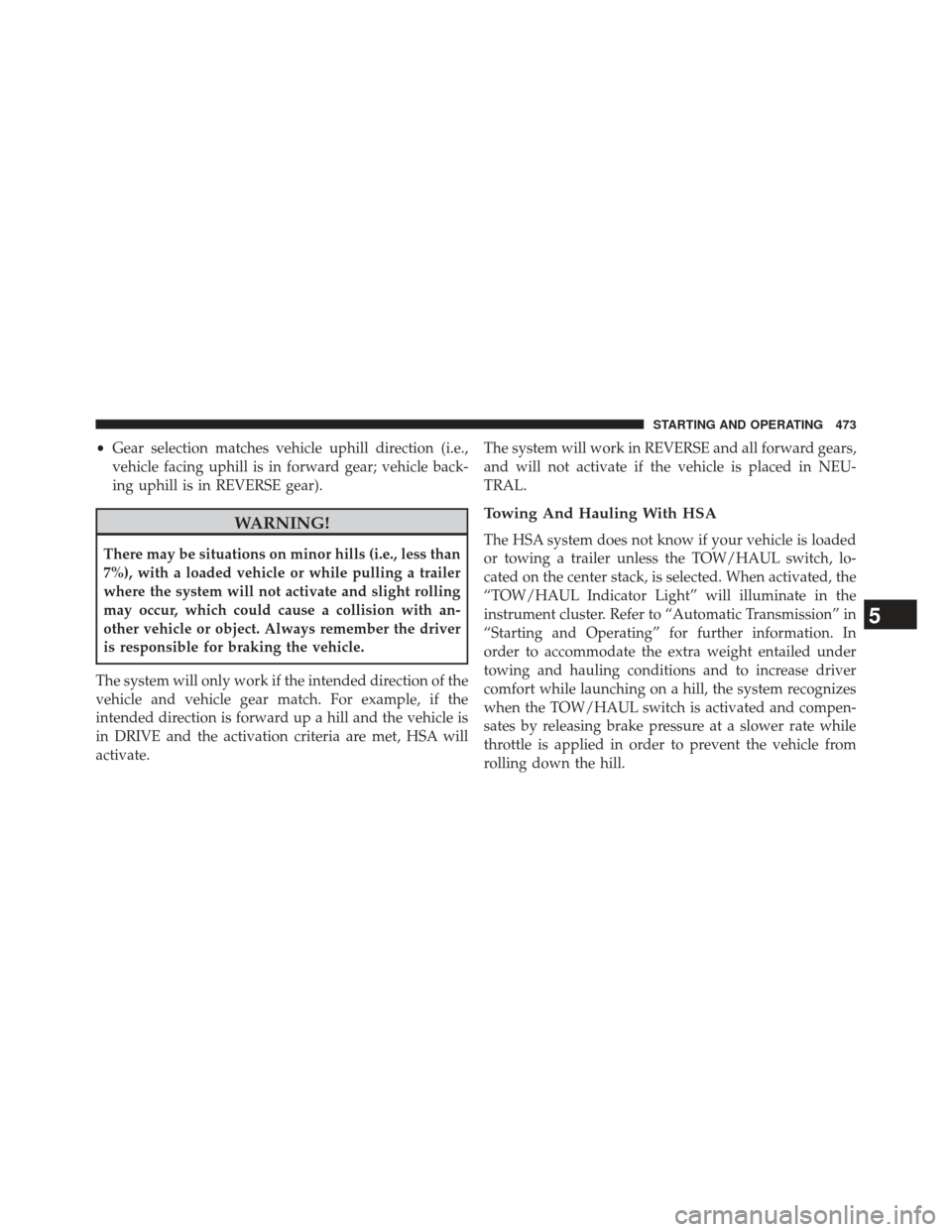
•Gear selection matches vehicle uphill direction (i.e.,
vehicle facing uphill is in forward gear; vehicle back-
ing uphill is in REVERSE gear).
WARNING!
There may be situations on minor hills (i.e., less than
7%), with a loaded vehicle or while pulling a trailer
where the system will not activate and slight rolling
may occur, which could cause a collision with an-
other vehicle or object. Always remember the driver
is responsible for braking the vehicle.
The system will only work if the intended direction of the
vehicle and vehicle gear match. For example, if the
intended direction is forward up a hill and the vehicle is
in DRIVE and the activation criteria are met, HSA will
activate. The system will work in REVERSE and all forward gears,
and will not activate if the vehicle is placed in NEU-
TRAL.
Towing And Hauling With HSA
The HSA system does not know if your vehicle is loaded
or towing a trailer unless the TOW/HAUL switch, lo-
cated on the center stack, is selected. When activated, the
“TOW/HAUL Indicator Light” will illuminate in the
instrument cluster. Refer to “Automatic Transmission” in
“Starting and Operating” for further information. In
order to accommodate the extra weight entailed under
towing and hauling conditions and to increase driver
comfort while launching on a hill, the system recognizes
when the TOW/HAUL switch is activated and compen-
sates by releasing brake pressure at a slower rate while
throttle is applied in order to prevent the vehicle from
rolling down the hill.
5
STARTING AND OPERATING 473
Page 483 of 734
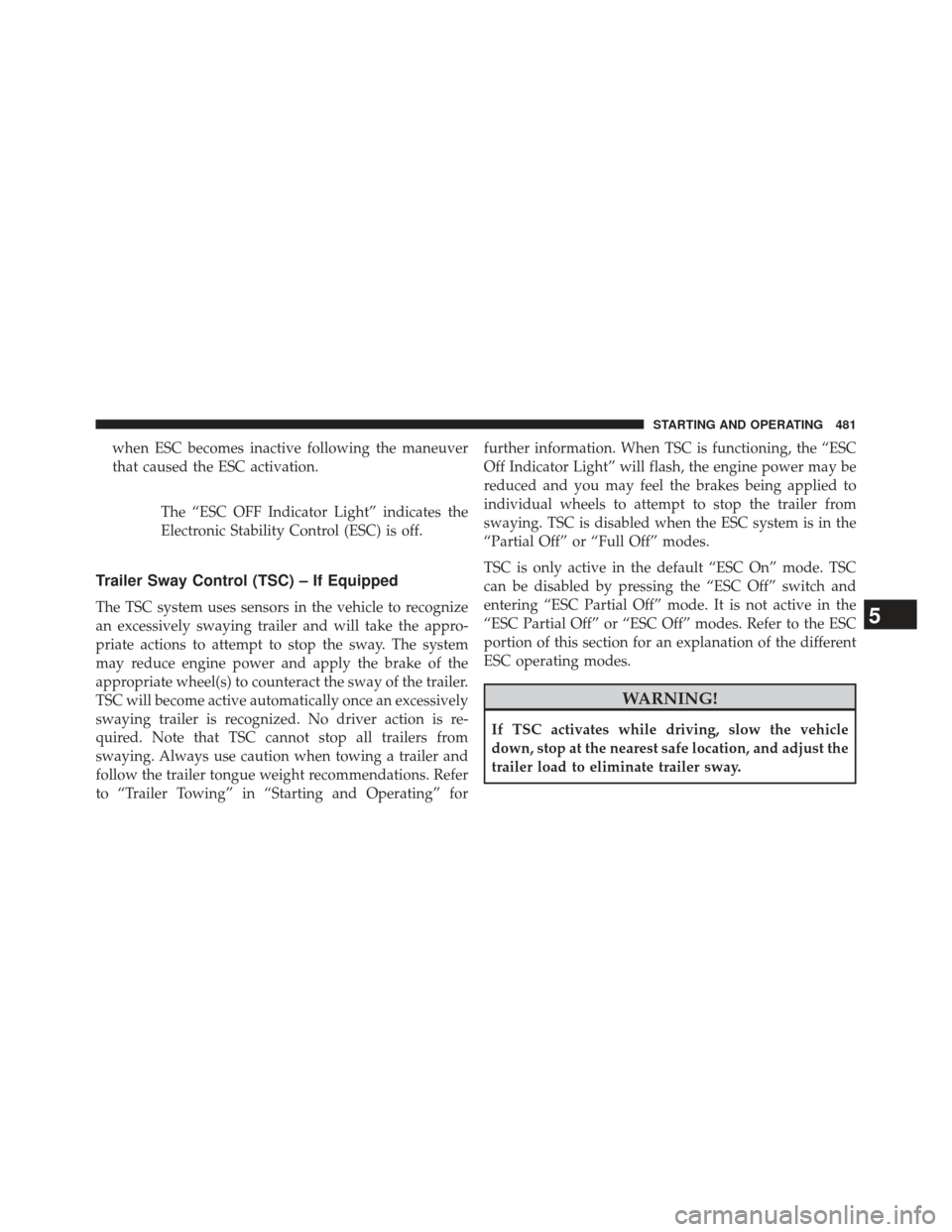
when ESC becomes inactive following the maneuver
that caused the ESC activation.The “ESC OFF Indicator Light” indicates the
Electronic Stability Control (ESC) is off.
Trailer Sway Control (TSC) – If Equipped
The TSC system uses sensors in the vehicle to recognize
an excessively swaying trailer and will take the appro-
priate actions to attempt to stop the sway. The system
may reduce engine power and apply the brake of the
appropriate wheel(s) to counteract the sway of the trailer.
TSC will become active automatically once an excessively
swaying trailer is recognized. No driver action is re-
quired. Note that TSC cannot stop all trailers from
swaying. Always use caution when towing a trailer and
follow the trailer tongue weight recommendations. Refer
to “Trailer Towing” in “Starting and Operating” for further information. When TSC is functioning, the “ESC
Off Indicator Light” will flash, the engine power may be
reduced and you may feel the brakes being applied to
individual wheels to attempt to stop the trailer from
swaying. TSC is disabled when the ESC system is in the
“Partial Off” or “Full Off” modes.
TSC is only active in the default “ESC On” mode. TSC
can be disabled by pressing the “ESC Off” switch and
entering “ESC Partial Off” mode. It is not active in the
“ESC Partial Off” or “ESC Off” modes. Refer to the ESC
portion of this section for an explanation of the different
ESC operating modes.
WARNING!
If TSC activates while driving, slow the vehicle
down, stop at the nearest safe location, and adjust the
trailer load to eliminate trailer sway.
5
STARTING AND OPERATING 481
Page 491 of 734
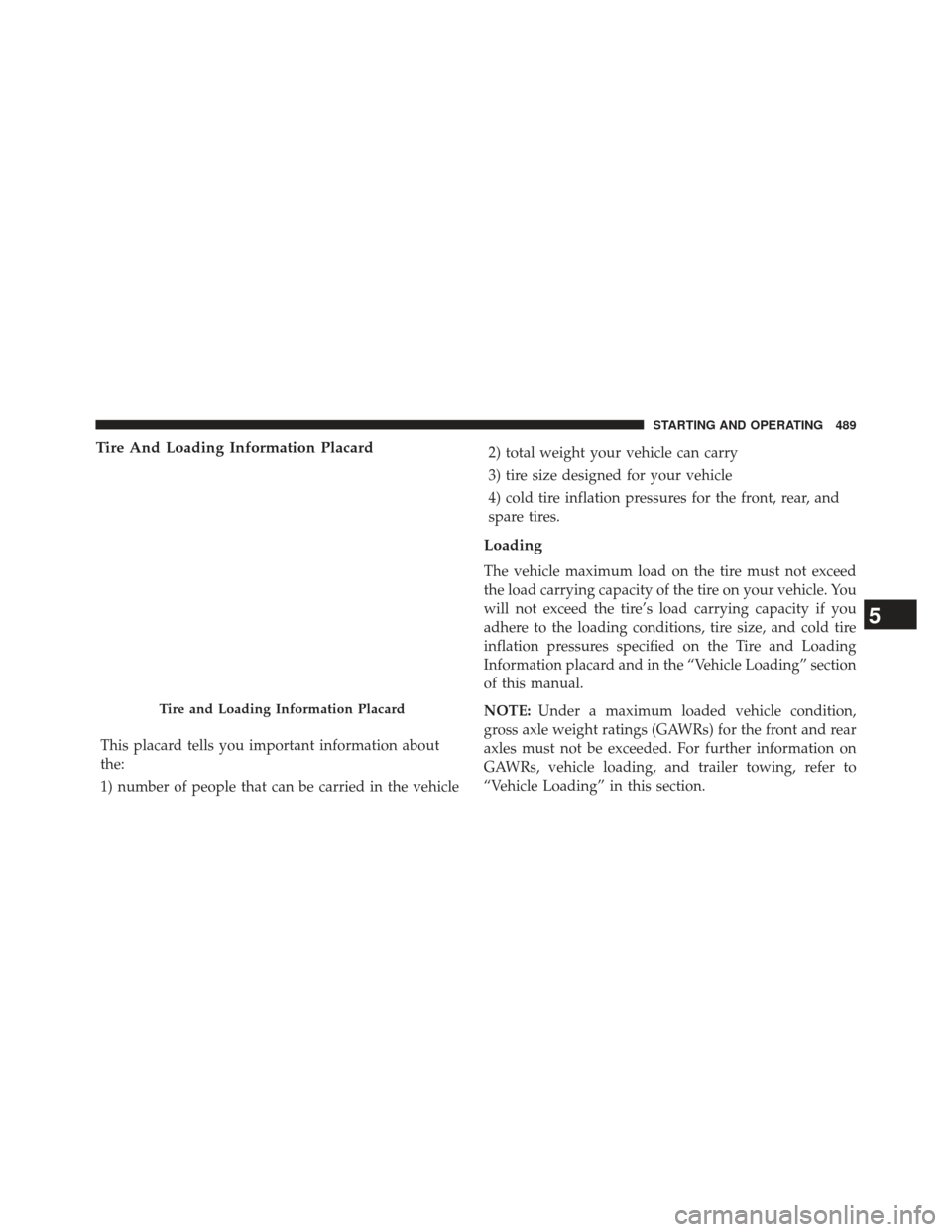
Tire And Loading Information Placard
This placard tells you important information about
the:
1) number of people that can be carried in the vehicle2) total weight your vehicle can carry
3) tire size designed for your vehicle
4) cold tire inflation pressures for the front, rear, and
spare tires.
Loading
The vehicle maximum load on the tire must not exceed
the load carrying capacity of the tire on your vehicle. You
will not exceed the tire’s load carrying capacity if you
adhere to the loading conditions, tire size, and cold tire
inflation pressures specified on the Tire and Loading
Information placard and in the “Vehicle Loading” section
of this manual.
NOTE:
Under a maximum loaded vehicle condition,
gross axle weight ratings (GAWRs) for the front and rear
axles must not be exceeded. For further information on
GAWRs, vehicle loading, and trailer towing, refer to
“Vehicle Loading” in this section.
Tire and Loading Information Placard
5
STARTING AND OPERATING 489
Page 492 of 734
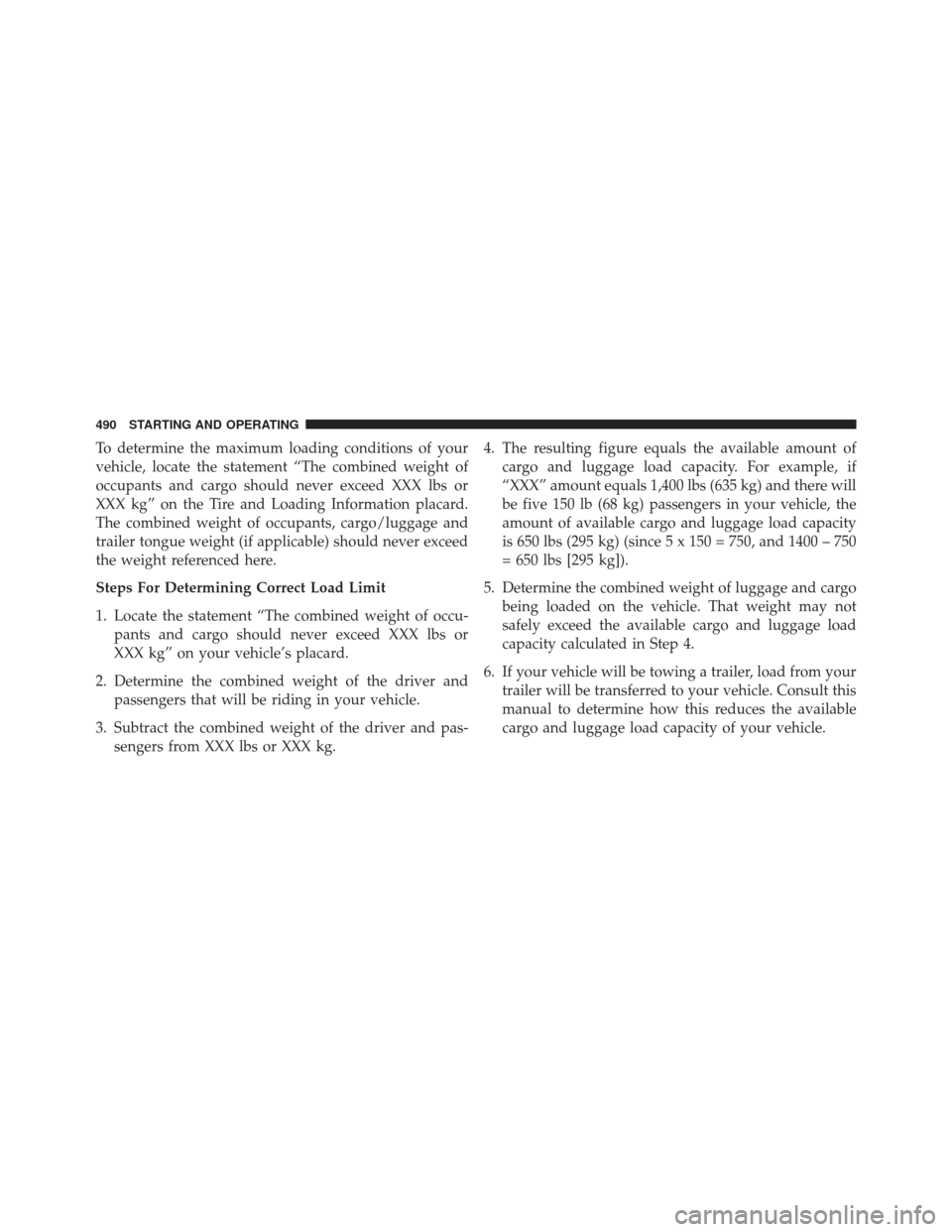
To determine the maximum loading conditions of your
vehicle, locate the statement “The combined weight of
occupants and cargo should never exceed XXX lbs or
XXX kg” on the Tire and Loading Information placard.
The combined weight of occupants, cargo/luggage and
trailer tongue weight (if applicable) should never exceed
the weight referenced here.
Steps For Determining Correct Load Limit
1. Locate the statement “The combined weight of occu-pants and cargo should never exceed XXX lbs or
XXX kg” on your vehicle’s placard.
2. Determine the combined weight of the driver and passengers that will be riding in your vehicle.
3. Subtract the combined weight of the driver and pas- sengers from XXX lbs or XXX kg. 4. The resulting figure equals the available amount of
cargo and luggage load capacity. For example, if
“XXX” amount equals 1,400 lbs (635 kg) and there will
be five 150 lb (68 kg) passengers in your vehicle, the
amount of available cargo and luggage load capacity
is 650 lbs (295 kg) (since 5 x 150 = 750, and 1400 – 750
= 650 lbs [295 kg]).
5. Determine the combined weight of luggage and cargo being loaded on the vehicle. That weight may not
safely exceed the available cargo and luggage load
capacity calculated in Step 4.
6. If your vehicle will be towing a trailer, load from your trailer will be transferred to your vehicle. Consult this
manual to determine how this reduces the available
cargo and luggage load capacity of your vehicle.
490 STARTING AND OPERATING
Page 493 of 734
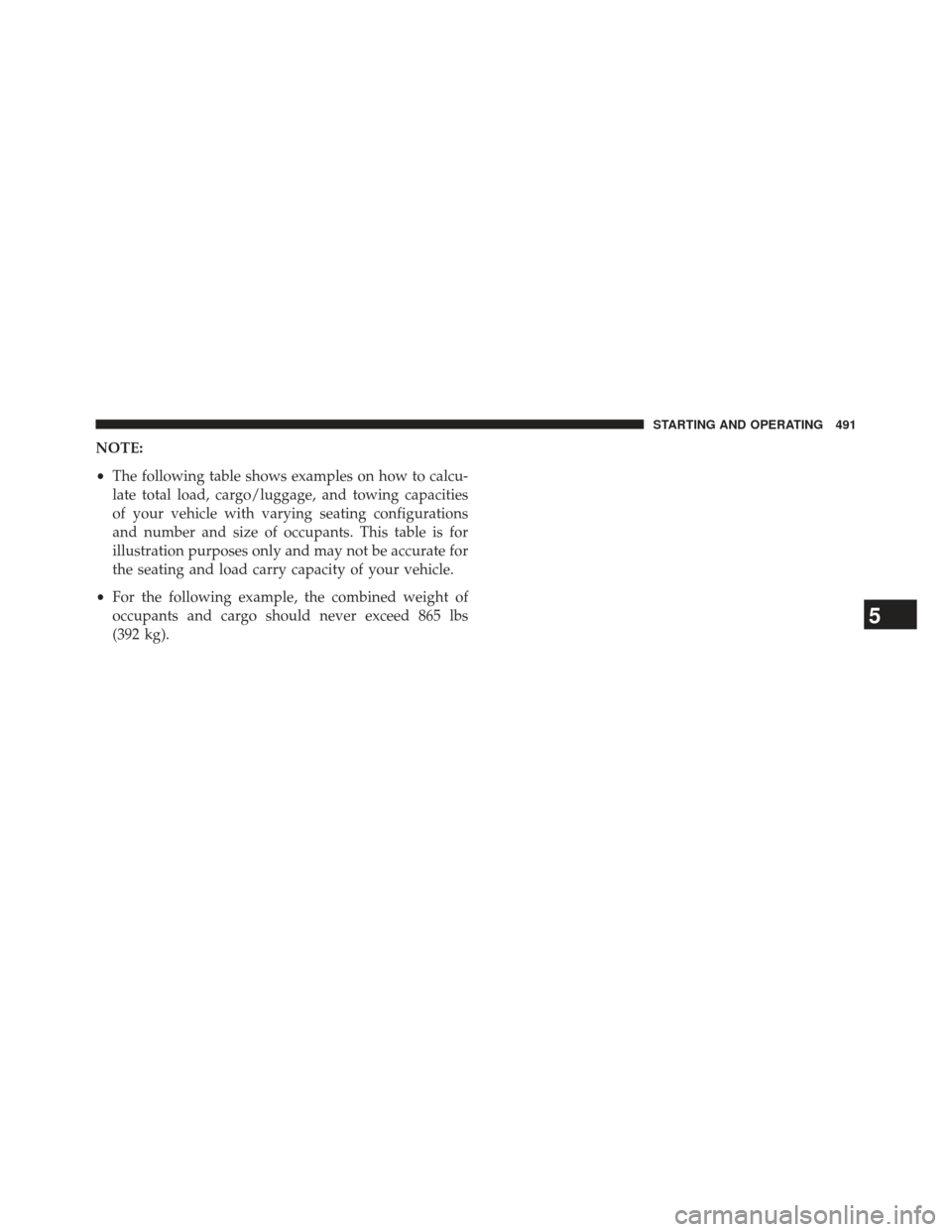
NOTE:
•The following table shows examples on how to calcu-
late total load, cargo/luggage, and towing capacities
of your vehicle with varying seating configurations
and number and size of occupants. This table is for
illustration purposes only and may not be accurate for
the seating and load carry capacity of your vehicle.
• For the following example, the combined weight of
occupants and cargo should never exceed 865 lbs
(392 kg).
5
STARTING AND OPERATING 491
Page 536 of 734
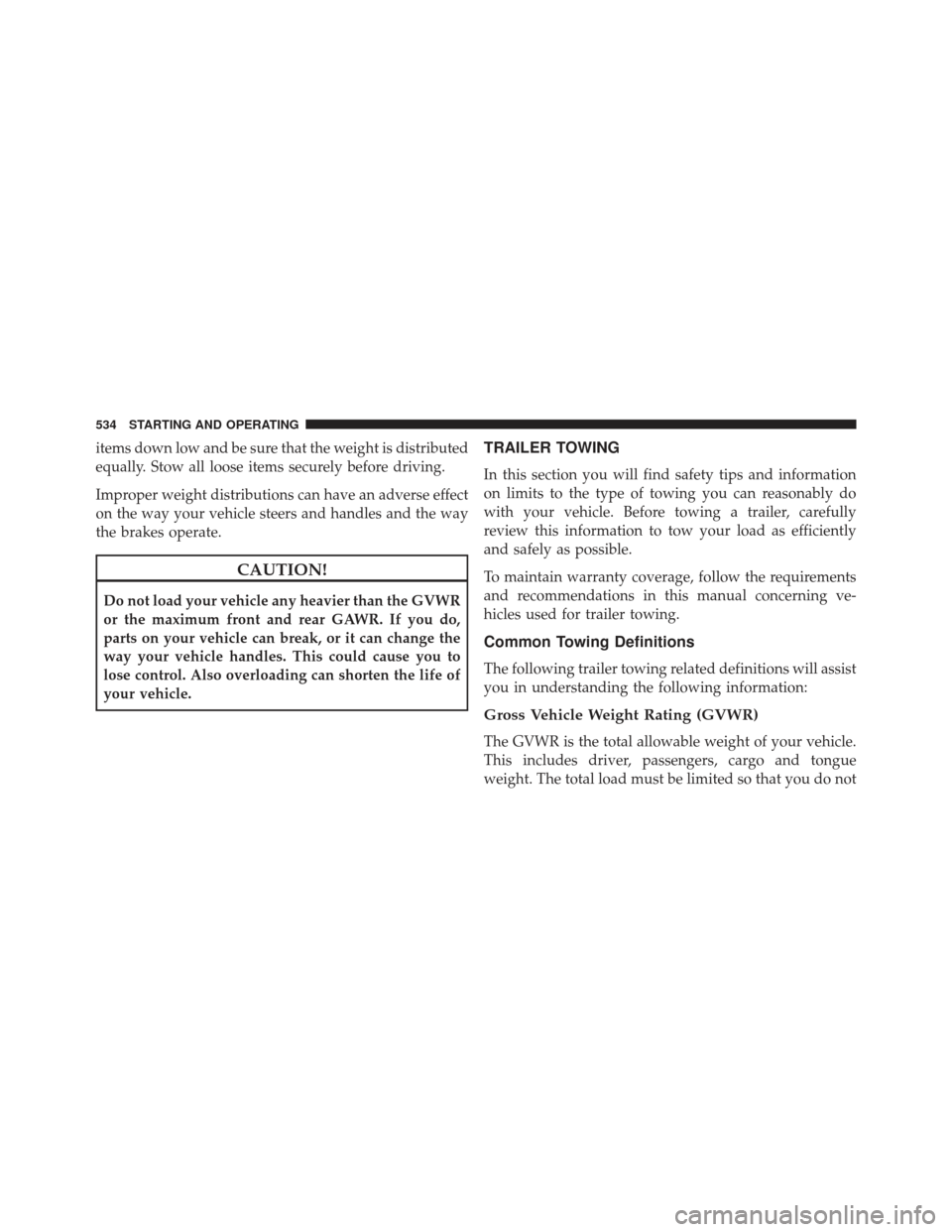
items down low and be sure that the weight is distributed
equally. Stow all loose items securely before driving.
Improper weight distributions can have an adverse effect
on the way your vehicle steers and handles and the way
the brakes operate.
CAUTION!
Do not load your vehicle any heavier than the GVWR
or the maximum front and rear GAWR. If you do,
parts on your vehicle can break, or it can change the
way your vehicle handles. This could cause you to
lose control. Also overloading can shorten the life of
your vehicle.
TRAILER TOWING
In this section you will find safety tips and information
on limits to the type of towing you can reasonably do
with your vehicle. Before towing a trailer, carefully
review this information to tow your load as efficiently
and safely as possible.
To maintain warranty coverage, follow the requirements
and recommendations in this manual concerning ve-
hicles used for trailer towing.
Common Towing Definitions
The following trailer towing related definitions will assist
you in understanding the following information:
Gross Vehicle Weight Rating (GVWR)
The GVWR is the total allowable weight of your vehicle.
This includes driver, passengers, cargo and tongue
weight. The total load must be limited so that you do not
534 STARTING AND OPERATING
Page 539 of 734
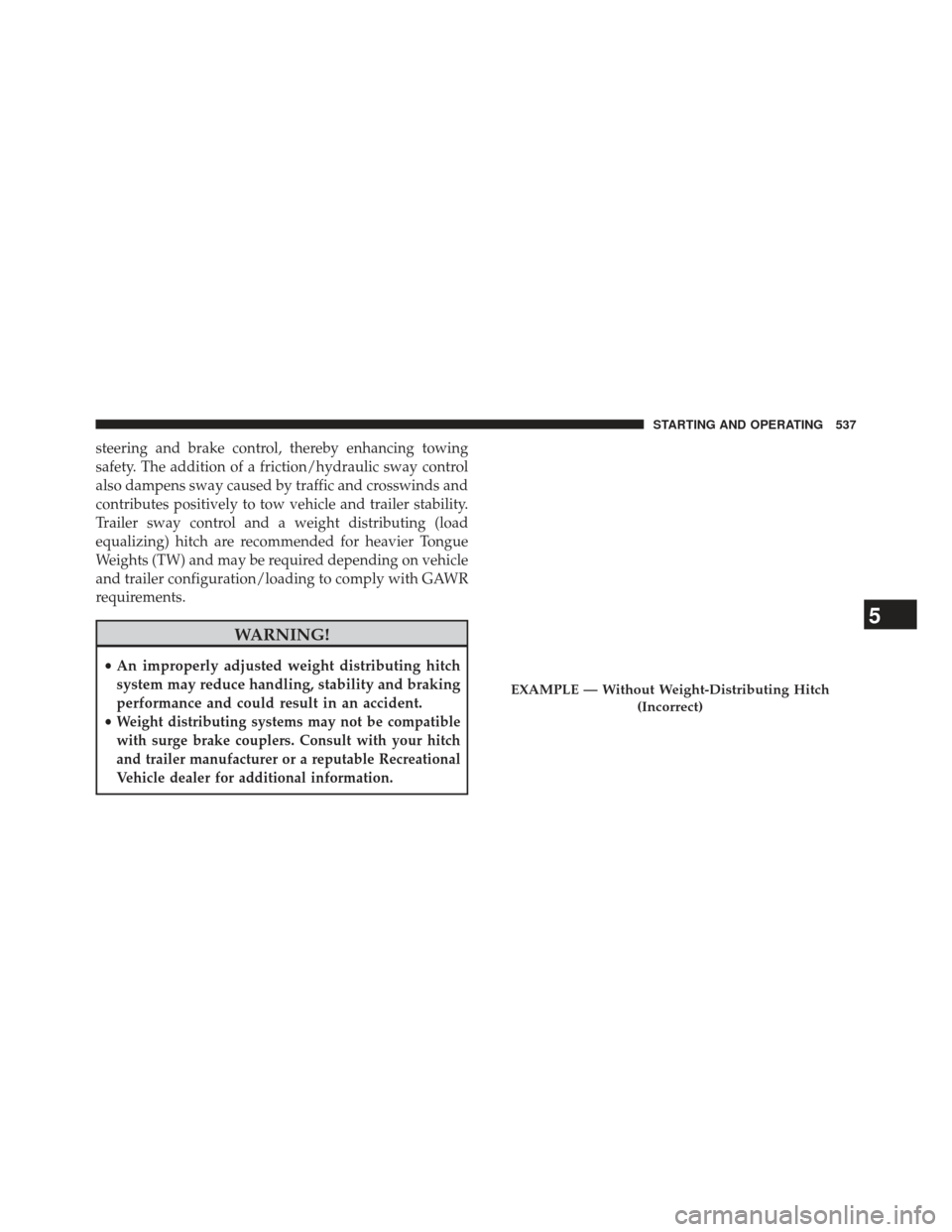
steering and brake control, thereby enhancing towing
safety. The addition of a friction/hydraulic sway control
also dampens sway caused by traffic and crosswinds and
contributes positively to tow vehicle and trailer stability.
Trailer sway control and a weight distributing (load
equalizing) hitch are recommended for heavier Tongue
Weights (TW) and may be required depending on vehicle
and trailer configuration/loading to comply with GAWR
requirements.
WARNING!
•An improperly adjusted weight distributing hitch
system may reduce handling, stability and braking
performance and could result in an accident.
•
Weight distributing systems may not be compatible
with surge brake couplers. Consult with your hitch
and trailer manufacturer or a reputable Recreational
Vehicle dealer for additional information.
EXAMPLE — Without Weight-Distributing Hitch
(Incorrect)
5
STARTING AND OPERATING 537
Page 541 of 734
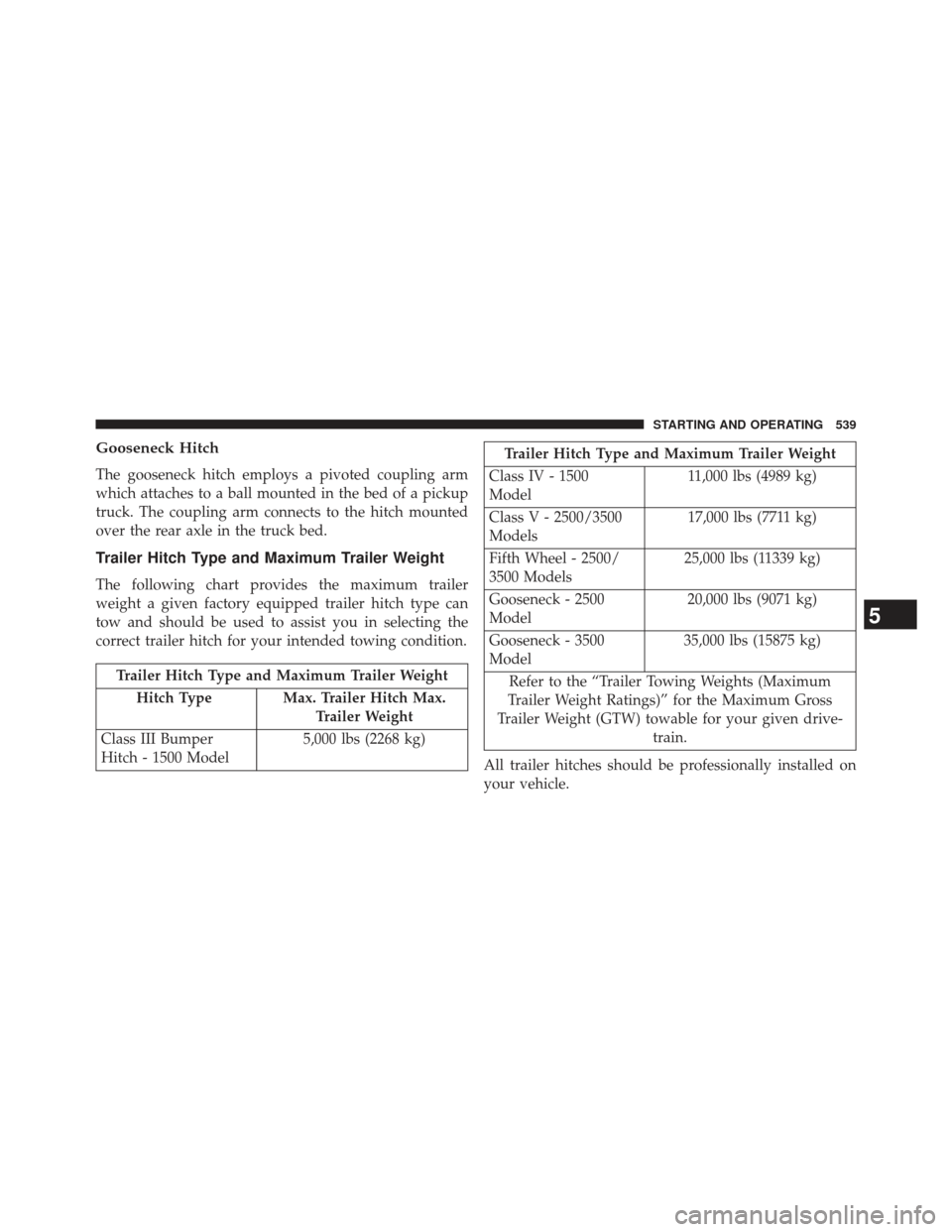
Gooseneck Hitch
The gooseneck hitch employs a pivoted coupling arm
which attaches to a ball mounted in the bed of a pickup
truck. The coupling arm connects to the hitch mounted
over the rear axle in the truck bed.
Trailer Hitch Type and Maximum Trailer Weight
The following chart provides the maximum trailer
weight a given factory equipped trailer hitch type can
tow and should be used to assist you in selecting the
correct trailer hitch for your intended towing condition.
Trailer Hitch Type and Maximum Trailer WeightHitch Type Max. Trailer Hitch Max. Trailer Weight
Class III Bumper
Hitch - 1500 Model 5,000 lbs (2268 kg)
Trailer Hitch Type and Maximum Trailer Weight
Class IV - 1500
Model 11,000 lbs (4989 kg)
Class V - 2500/3500
Models 17,000 lbs (7711 kg)
Fifth Wheel - 2500/
3500 Models 25,000 lbs (11339 kg)
Gooseneck - 2500
Model 20,000 lbs (9071 kg)
Gooseneck - 3500
Model 35,000 lbs (15875 kg)
Refer to the “Trailer Towing Weights (Maximum
Trailer Weight Ratings)” for the Maximum Gross
Trailer Weight (GTW) towable for your given drive- train.
All trailer hitches should be professionally installed on
your vehicle.
5
STARTING AND OPERATING 539
Page 542 of 734
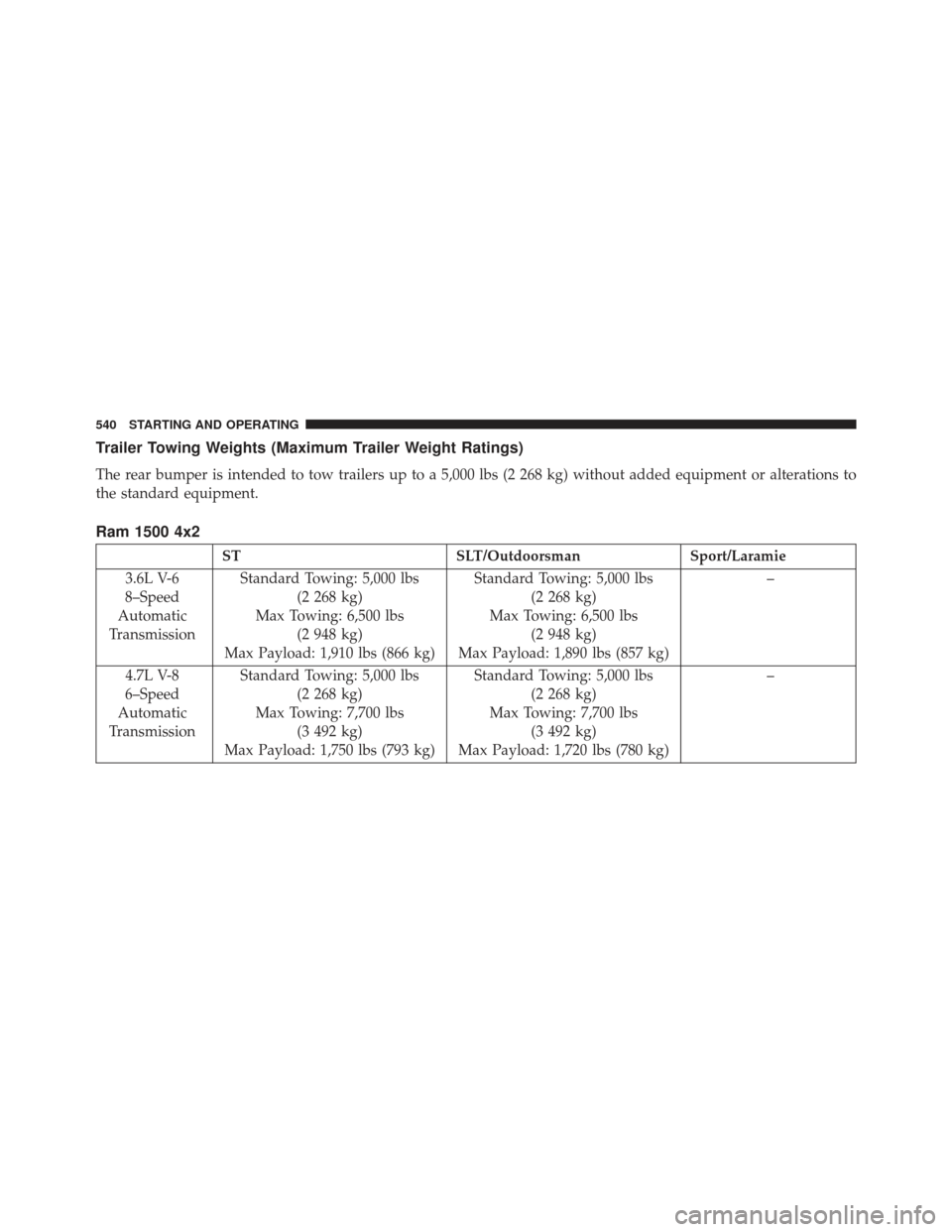
Trailer Towing Weights (Maximum Trailer Weight Ratings)
The rear bumper is intended to tow trailers up to a 5,000 lbs (2 268 kg) without added equipment or alterations to
the standard equipment.
Ram 1500 4x2
STSLT/OutdoorsmanSport/Laramie
3.6L V-6
8–Speed
Automatic
Transmission Standard Towing: 5,000 lbs
(2 268 kg)
Max Towing: 6,500 lbs (2 948 kg)
Max Payload: 1,910 lbs (866 kg) Standard Towing: 5,000 lbs
(2 268 kg)
Max Towing: 6,500 lbs (2 948 kg)
Max Payload: 1,890 lbs (857 kg) –
4.7L V-8
6–Speed
Automatic
Transmission Standard Towing: 5,000 lbs
(2 268 kg)
Max Towing: 7,700 lbs (3 492 kg)
Max Payload: 1,750 lbs (793 kg) Standard Towing: 5,000 lbs
(2 268 kg)
Max Towing: 7,700 lbs (3 492 kg)
Max Payload: 1,720 lbs (780 kg) –
540 STARTING AND OPERATING
Page 543 of 734
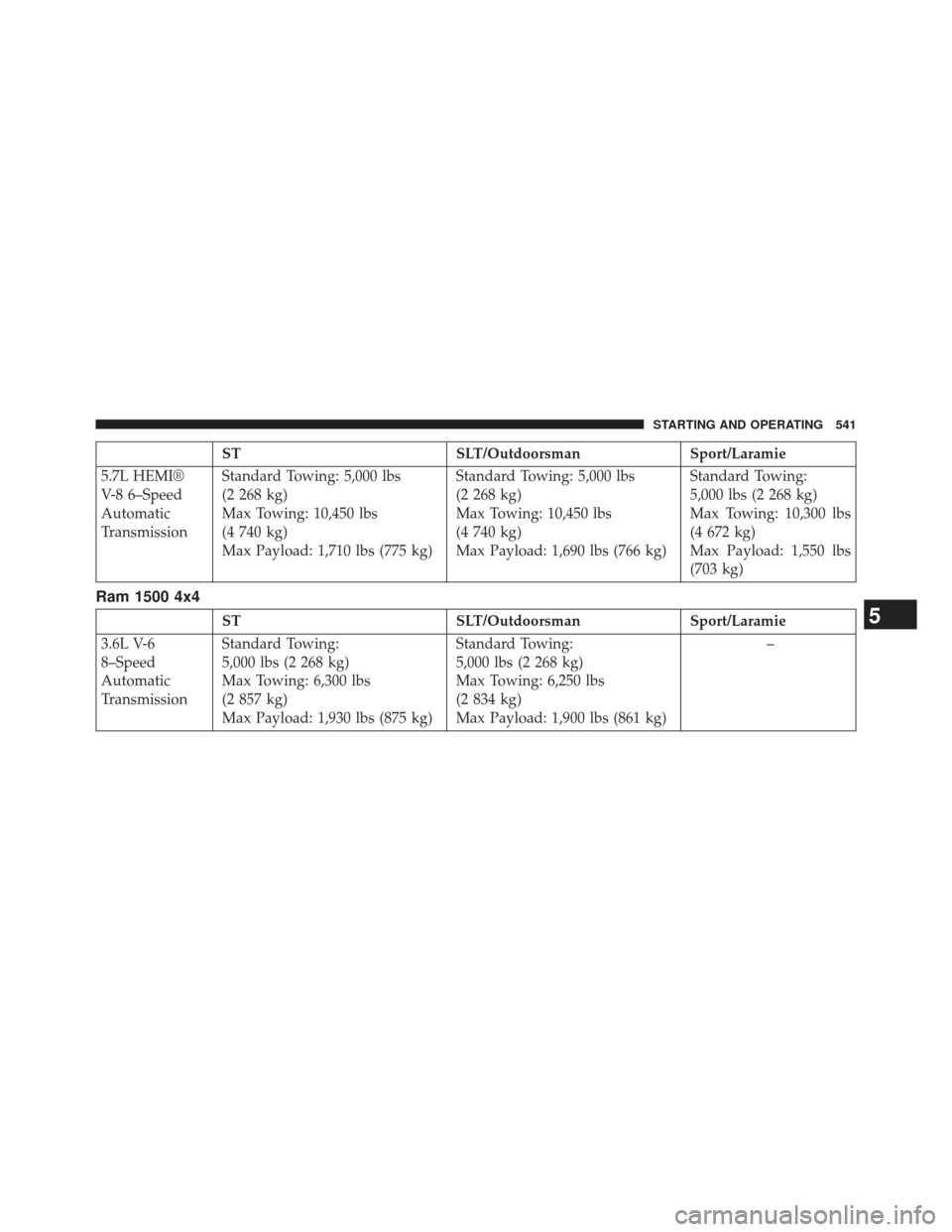
STSLT/OutdoorsmanSport/Laramie
5.7L HEMI®
V-8 6–Speed
Automatic
Transmission Standard Towing: 5,000 lbs
(2 268 kg)
Max Towing: 10,450 lbs
(4 740 kg)
Max Payload: 1,710 lbs (775 kg) Standard Towing: 5,000 lbs
(2 268 kg)
Max Towing: 10,450 lbs
(4 740 kg)
Max Payload: 1,690 lbs (766 kg)Standard Towing:
5,000 lbs (2 268 kg)
Max Towing: 10,300 lbs
(4 672 kg)
Max Payload: 1,550 lbs
(703 kg)
Ram 1500 4x4
ST
SLT/OutdoorsmanSport/Laramie
3.6L V-6
8–Speed
Automatic
Transmission Standard Towing:
5,000 lbs (2 268 kg)
Max Towing: 6,300 lbs
(2 857 kg)
Max Payload: 1,930 lbs (875 kg) Standard Towing:
5,000 lbs (2 268 kg)
Max Towing: 6,250 lbs
(2 834 kg)
Max Payload: 1,900 lbs (861 kg) –5
STARTING AND OPERATING 541